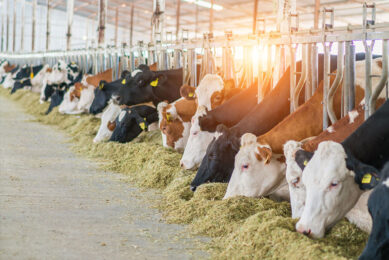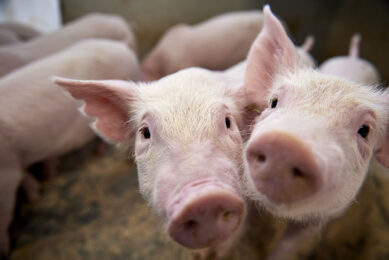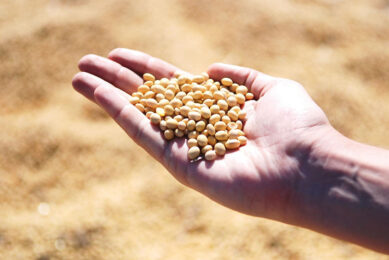Milk feeding calves in tropical conditions
![It must be remembered that most dairy calves in the tropics, whether from Bos indicus or Bos taurus, are smaller at birth and grow more slowly than they would in the temperate zones. Different feeding strategies might apply for these calves. [Photo: Shutterstock]](https://www.allaboutfeed.net/app/uploads/2020/12/001_405_rb-image-2668387.jpeg)
Rearing young stock on tropical dairy farms in Asia can be challenging. Here we discuss some of the decisions that have to be made when planning the milk feeding program for replacement heifer calves.
The diversity of climate, milk returns and concentrate costs throughout Asia have created a wide range in calf rearing systems. The length of time, if at all, that calves remain housed, the method and level of milk feeding, the type of solid feeds offered and the age and weight at weaning therefore vary widely. The simplest rearing system involves putting young calves out to pasture, giving them access to trees or a simple shed for shelter and feeding them whole milk to appetite (ad lib) from a trough or feeding drum for up to 12 weeks of age, but with no additional concentrates. The other extreme would be to house calves for the first two months and feed them limited milk (or milk replacer), specially formulated concentrate mixes plus limited amounts of low quality roughage. This encourages early rumen development and also achieves high pre-weaning growth rates. In both cases, it is the people who rear the calves not the system. The calf rearer teaches the animals to drink and decides on when and how the milk should be fed. In this article we focus on different types of milk and the choice of feeding methods.
The choice of liquid feeds
The term colostrum is generally used to describe all milk not accepted by milk processors. However, a more correct term for milk produced after the second milking post-calving is transition milk. This milk no longer contains enough immunoglobulins to provide maximum immunity to calves, but still contains other components, which reduce its suitability for milk processing. Milk from newly calved cows should not be put into the bulk milk vat for up to eight days after calving. Regulations vary between countries and between different situations. During this period, cows will produce considerably more colostrum or transition milk than that consumed fresh by her calf. If only rearing heifer replacements, the colostrum produced by cows, that have given birth to bull and cull heifer calves, would then be available for milk feeding. Using a 25% heifer replacement rate and 45 L colostrum and transition milk per cow available for heifer rearing, this can provide up to 180 L milk available per reared calf. These calculations take into account any milk used for early feeding of bull and cull heifer calves. There should be little need for dairy farmers to buy milk replacer or use marketable whole milk to rear their heifer replacements. Dairy farmers can save considerable money through modifying their transition milk storage systems to minimise the need to feed marketable milk or milk replacer to their heifer calves. Transition milk has the greatest value when fed fresh or within a day or two from milking. It can be stored in a refrigerator for a week or so, or in a freezer for up to 12 months. In most farm situations, neither method is very practical for routine storage, except for a small supply of frozen colostrum for emergency use with newborn calves. There is little difference in the immunoglobulin levels in frozen compared to fresh colostrum. Only the first few litres of colostrum produced immediately after calving from older cows should be frozen for later use as a source of immunoglobulins. The ideal method to freeze the colostrum is in 1 litre plastic bags placed in flat trays. This will produce wafers of colostrum about 2 to 3 cm thick, which can be rapidly thawed in lukewarm water. Very hot water should not be used to thaw the frozen colostrum because it can reduce its effectiveness in providing immunoglobulins. Extremely bloody colostrum or colostrum from cows freshly treated for mastitis should not be stored, although it can be fed fresh, to calves not to be sold.
Proper storage of milk
Natural fermentation is an excellent way for storing transition milk for feeding as a source of cheap nutrients. It must be handled in clean containers to prevent contamination and should be kept in plastic or plastic-lined containers with lids. Old stainless steel milk vats are also ideal. If stored below 20oC, the natural fermentation will make the milk acid, stopping spoilage for up to 12 weeks. In warm conditions, preservatives may need to be added. These include propionic acid or formalin. The stored milk should be stirred every day to maintain uniform consistency and fresh milk should be cooled before adding to it. The preserved liquid will develop a characteristic odour but calves will continue to drink it provided they are not abruptly switched from fresh milk or milk replacer to stored milk. They may refuse to drink it if it becomes too acidic. In this case, its palatability can be improved by neutralising it with sodium bicarbonate or baking soda at the rate of 10 g/L milk. Fresh colostrum has a slightly greater feed value than whole milk so less can be fed or small quantities of warm water can be added to feed at the same rate as whole milk. When teaching calves to drink stored transition milk, it may be easier to begin feeding it warm, hence diluted with warm water (hot water will curdle it) and then gradually change to cool, stored milk when calves are drinking more confidently. Calves will continue to drink such stored milk long after the rearer can’t bear to get too close to it. When the supply of stored transition milk begins to run out, fresh milk or milk replacer should gradually replace it over a week or so to give the calves time to accept their new diet. Changing from fresh milk or milk replacer back to stored transition milk can reduce intakes and lower growth rates.
Use of whole milk or milk replacer
Whole milk is the ideal food for calves. It has a high energy value and the correct balance of protein, minerals and vitamins for good calf growth and development. Health problems are generally lower when feeding whole milk compared to milk replacer as there is guaranteed quality control of the sources of protein and energy and there is no need to have to follow recipes to ensure the correct strength for proper feeding. Whole milk can either be the commercial milk being sold or it can be waste milk, that is milk from treated cows or mastitic milk that cannot be sold. Calves fed whole milk are less prone to scours than those fed milk replacer. Although it is common practice to feed mastitic whole milk to heifer replacement calves, recent evidence suggests that this could lead to an increased incidence in herd levels of mastitis in later years. Whole milk and milk replacer can both be preserved by acidification for easier feeding management. Formalin can be added at the rate of 1-5 ml/L milk or hydrogen peroxide at the rate of 5 ml/L milk. Acidification can be achieved through adding 1.5 g citric acid/L milk or including a buttermilk culture (or non-pasteurised yoghurt) to ferment the milk. If the milk is made too acid, calves’ daily intake will be reduced. To many producers, the decision on whether to feed whole milk or calf milk replacer (CMR) during rearing depends largely on cost. Sourcing a consistent quality of the milk replacer and its convenience for feeding are other factors influencing its use. Some farmers are concerned with the marked variation in milk replacer quality from batch to batch. Even though whole milk may be cheaper, it may not always be readily available for feeding to calves. For example, the calf feeding area may be some distance from the milking parlour.
The choice of feeding methods
Calves should be started on buckets then confined to a small yard to feed for a few days until they get used to trough feeding. Groups of calves will have more uniform growth rates when matched for drinking speed and age or size. Each animal should be allocated a feeding space of 35 cm or if using rubber teats, one teat per calf. Rubber teats give no additional nutritional benefit over bucket feeding as the speed of drinking milk has little effect on its utilisation. However, the production of saliva is greater in teat-fed calves and it may help maintain fluid intake in scouring calves. Teat feeding has also been shown to reduce the incidence of pizzle sucking in calves housed in groups. More capital is required in setting up the system and more labour is required for feeding and cleaning. One way of group feeding calves using teats is with a suckle bar. This can be made from 50 mm PVC piping fitted with milk line entries and self-closing teats. Milk is poured into one end and sucked out by the calves. It saves carting milk and is easy to wash. Calfeterias and feeding drums are used with rubber teats and can feed large numbers of calves quickly. Because the milk can always remain covered they can be fed away from shelter. The calf controls the amount of milk taken per feed so scouring is usually reduced provided the total milk provided is consistent. They can then be used for ad lib feeding. With calfeterias, the teats are either positioned in a metal frame which is attached to the top of the milk reservoir with plastic tubes to draw milk from inside the reservoir, or the milk reservoir allows the milk to run into the teats’ by gravity. Modern calfeterias are made from moulded plastic to provide a reservoir of 2 or 4 L per teat.

The diversity of climate, milk returns and concentrate costs throughout Asia have created a wide range in calf rearing systems. The length of time, if at all, that calves remain housed, the method and level of milk feeding, the type of solid feeds offered and the age and weight at weaning therefore vary widely. [Photo: Shutterstock]
Automatic calf feeders
In recent years, automatic calf feeding (ACF) machines have become popular on many large scale calf rearing operations. Calves can enter and leave the milk or concentrate feeding station at will but its feeding regime is controlled by computer technology. Each ACF machine can handle four teats and/or concentrate dispensers, thus allowing up to 100 calves to be reared in a single group. They are promoted as labour saving devices which can provide for a more carefully controlled milk feeding program. Each calf is individually identified to allow its milk feeding regime to be controlled by pre-determined programs of daily milk allocations. Some machines also allow for controlled concentrate feeding as well. ACF technology is not cheap, since as well as the initial capital investment of the machine and associated computer software, each calf will require an electronic ear tag and the calf rearing shed has to be modified to hold larger groups of calves. Because calves can be reared in large groups, extra surveillance is also required to minimise issues with animal health and behaviour. Their potential for integrating into calf rearing systems in tropical Asia will be limited by the relatively low cost of farm labour and the need for extra management skills.
Specific decisions for the tropicsDecisions on the most suitable milk rearing systems for calves often depend on local circumstances. For example, in regions where ghee or butter is produced, skim milk and milk substitutes are becoming increasingly available in the tropics as livestock feed industries develop. What must be remembered is that the environment in most tropical countries is more hostile for the dairy calf than in temperate regions and that it is more economic to spend additional money on calf rearing in order to reduce calf mortality and increase live weight gains. It must also be remembered that most dairy calves in the tropics, whether from Bos indicus or Bos taurus, are smaller at birth and grow more slowly than they would in the temperate zones. Thus temperate feeding standards are not completely applicable in the tropics and, if adhered to, may lead to some overfeeding of calves. In the tropics it is probably more economic to feed calves on additional milk than to attempt to early wean them as say five to six weeks of age. There are obviously many compromises with managing dairy calves in the tropics and ten or even twelve weeks of milk feeding is more the norm. |
How much milk to feed?
When fed ad lib, six week old Friesian calves can drink up to 12 L/day and Jerseys up to 9 L/day of whole milk. By the time the calves reach six months of age, any live weight advantage in calves previously fed ad lib milk, compared to restricted milk, is lost. With access to concentrates and good quality pasture together with once or twice daily feeding of 4-5 L whole milk/day, Friesians should reach a suitable weaning weight (70 kg) in nine weeks and Jerseys (60 kg) in ten to twelve weeks. Many farmers still use live weight as their major criterion for weaning, often feeding more milk than is really necessary. Although ad lib milk feeding is more expensive than other rearing systems, this system is often justified through faster growth rates and lower labour requirements, if using drum feeding. Earlier weaning compensates for the greater milk intake of ad lib fed calves and advocates of this system argue that it uses only slightly more milk over the whole period compared to restricted milk feeding. Provided that there are no setbacks to growth, weaning can occur as early as six weeks of age. Some farmers claim to be able to wean such young calves directly onto pasture but it is unlikely that rumen development would be sufficient and a severe growth check would be likely. If considering such a rearing system, calves would have to be fed 0.5-1 kg/day of concentrates at least until they are ten weeks old. Many experienced calf rearers in Australia initially feed milk twice daily at 10% the calves’ live weight for the first few weeks and provide fresh concentrates and drinking water each day within the first week of age. This ensures each calf has a ‘good start to life’ with high immunity to diseases and a positive energy balance. Only then will they restrict the milk or feed it once each day, which will stimulate concentrate intake and allow for a successful early weaning program. After weaning, consumption of concentrates should increase to 2 kg/day until the animals are three to four months of age. Concentrates can then be gradually withdrawn, provided good pasture or forages are plentiful. This early weaning system is low cost and has minimal labour requirements once milk feeding ceases.
This article is based on the book: Rearing Young Stock on Tropical Dairy Farms in Asia, written by John Moran.












